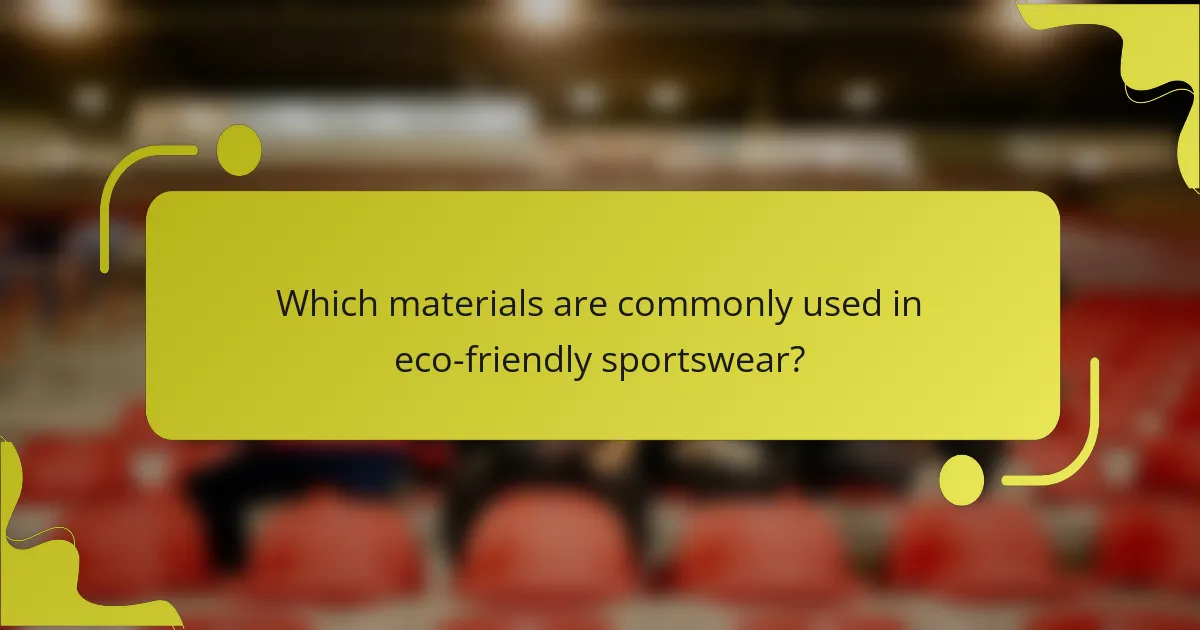Eco-friendly sportswear significantly reduces environmental impact while enhancing comfort and performance. This article explores sustainable materials like organic cotton and recycled polyester, highlights the benefits of these garments, and examines current market trends driving growth in this sector. Understanding these aspects helps consumers make informed choices in their athletic apparel.

What are the key benefits of eco-friendly sportswear?
Eco-friendly sportswear offers numerous benefits, including reduced environmental impact, enhanced comfort, and improved performance. These garments utilize sustainable materials like organic cotton and recycled polyester, which minimize waste and pollution. Additionally, eco-friendly sportswear often features moisture-wicking and breathable properties, promoting better athletic performance. As consumer awareness grows, the market for eco-friendly sportswear is expanding, reflecting a shift towards sustainable fashion choices.
How do sustainable materials impact performance?
Sustainable materials enhance performance by providing breathability, moisture-wicking, and durability. Eco-friendly fabrics like organic cotton and recycled polyester reduce environmental impact while maintaining comfort and functionality. These materials often outperform traditional options in terms of lightweight properties and flexibility, contributing to better athletic performance. Additionally, brands focusing on sustainability report increased consumer interest, aligning performance with ethical practices.
Why is eco-friendliness important for athletes?
Eco-friendliness is crucial for athletes as it promotes sustainability and reduces environmental impact. Eco-friendly sportswear uses materials that minimize pollution and waste, appealing to environmentally conscious consumers. This shift supports a healthier planet while enhancing brand loyalty among athletes who prioritize sustainability. Athletes adopting eco-friendly practices can inspire others, contributing to a broader movement towards environmental responsibility in sports.

Which materials are commonly used in eco-friendly sportswear?
Eco-friendly sportswear commonly uses materials like organic cotton, recycled polyester, Tencel, hemp, and bamboo. These materials are sustainable and reduce environmental impact. Organic cotton is grown without harmful chemicals, while recycled polyester repurposes plastic waste. Tencel is biodegradable and made from sustainably sourced wood pulp. Hemp is durable and requires less water, and bamboo is fast-growing and naturally antibacterial. These attributes contribute to the overall sustainability of eco-friendly sportswear.
How do recycled fabrics compare to traditional materials?
Recycled fabrics offer significant environmental advantages over traditional materials. They reduce waste and lower carbon footprints by repurposing existing materials.
Recycled fabrics often use less water and energy during production compared to conventional textiles. For example, producing recycled polyester can save up to 70% of the energy required for virgin polyester.
Additionally, recycled fabrics contribute to the circular economy by minimizing resource extraction. This approach supports sustainability in the sportswear market, aligning with growing consumer demand for eco-friendly options.
In terms of performance, recycled fabrics can match or even exceed the quality of traditional materials. Many brands are now prioritizing these materials, reflecting a shift in market trends towards more sustainable practices.
What role do organic materials play in sustainability?
Organic materials play a crucial role in sustainability by reducing environmental impact and promoting eco-friendly practices. They are biodegradable, minimizing waste and pollution. In eco-friendly sportswear, organic fabrics like cotton, hemp, and bamboo are favored for their low resource consumption and reduced carbon footprint. These materials enhance breathability and comfort, catering to health-conscious consumers. As a result, the market for sustainable sportswear is growing, reflecting a shift towards responsible consumerism.

How is the eco-friendly sportswear market evolving in 2025?
The eco-friendly sportswear market is projected to grow significantly in 2025 due to increased consumer awareness and demand for sustainable products. Key trends include the use of recycled materials, innovation in biodegradable fabrics, and a focus on ethical manufacturing practices. Brands are emphasizing transparency in their supply chains, appealing to environmentally conscious consumers. As a result, the market is expected to expand with more diverse product offerings and improved performance features.
What are the latest trends in sustainable fashion?
Eco-friendly sportswear is gaining momentum, driven by innovative materials and consumer demand for sustainability. Key trends include the use of recycled fabrics, organic cotton, and biodegradable materials. Brands are increasingly adopting transparent supply chains and eco-conscious production processes. As a result, the market for sustainable sportswear is projected to grow significantly, with consumers prioritizing ethical choices.
Which brands are leading the way in eco-friendly sportswear?
Leading brands in eco-friendly sportswear include Patagonia, Adidas, Nike, and Reebok. These companies utilize sustainable materials like recycled polyester and organic cotton, enhancing their environmental impact. Patagonia emphasizes ethical production and transparency, while Adidas focuses on ocean plastic recycling. Nike’s Move to Zero initiative aims for zero carbon and waste. Reebok promotes plant-based materials, showcasing innovation in sustainability. These brands are setting market trends by prioritizing eco-conscious practices and appealing to environmentally aware consumers.

What challenges do manufacturers face in producing eco-friendly sportswear?
Manufacturers face significant challenges in producing eco-friendly sportswear, including sourcing sustainable materials, maintaining performance standards, and managing production costs. The availability of high-quality, biodegradable fabrics is limited, which can hinder product development. Additionally, eco-friendly processes often require more time and investment, impacting overall profitability. Balancing consumer demand for sustainability with competitive pricing poses a further challenge. Lastly, ensuring transparency in the supply chain can be complex, complicating efforts to market products as genuinely eco-friendly.
How do production costs affect pricing for consumers?
Production costs significantly influence consumer pricing for eco-friendly sportswear. Higher-quality sustainable materials often lead to increased production costs, which are reflected in retail prices. For instance, organic cotton or recycled polyester typically costs more than conventional fabrics. As a result, consumers may pay a premium for products that align with their environmental values. Additionally, market trends indicate a growing willingness among consumers to invest in sustainable options, despite higher prices. This shift suggests that the perceived benefits of eco-friendly sportswear can justify the increased costs for many buyers.
What are the environmental impacts of the sportswear industry?
The sportswear industry significantly impacts the environment through resource depletion, pollution, and waste. Eco-friendly sportswear aims to mitigate these effects by utilizing sustainable materials and practices.
A major environmental concern is the production of synthetic fibers, which contributes to microplastic pollution in oceans. In contrast, eco-friendly materials like organic cotton and recycled polyester reduce reliance on fossil fuels and lower carbon footprints.
The industry is also addressing waste through circular economy initiatives, promoting recycling and upcycling of old sportswear. As a result, brands are increasingly adopting sustainable practices, responding to consumer demand for environmentally responsible products.
Market trends indicate a growing preference for eco-friendly options, with consumers prioritizing brands that demonstrate commitment to sustainability. This shift is influencing product development and marketing strategies across the sportswear sector.

How can consumers make informed choices when purchasing eco-friendly sportswear?
Consumers can make informed choices when purchasing eco-friendly sportswear by researching materials, understanding benefits, and following market trends.
Choosing sustainable materials like organic cotton or recycled polyester enhances environmental impact. Benefits include reduced carbon footprint and improved durability. Keeping up with market trends, such as the rise of biodegradable fabrics, helps consumers identify innovative products. Additionally, certifications like Global Organic Textile Standard (GOTS) provide assurance of eco-friendly practices.
What certifications should you look for in sustainable products?
Look for certifications like Global Organic Textile Standard (GOTS), OEKO-TEX Standard 100, and Fair Trade Certified when choosing sustainable sportswear. These certifications ensure environmentally friendly materials, ethical production practices, and safety for consumers. GOTS focuses on organic fibers, OEKO-TEX tests for harmful substances, and Fair Trade promotes fair labor conditions. Selecting certified products supports sustainability and ethical manufacturing in the sportswear market.
Which features enhance the longevity of eco-friendly sportswear?
Eco-friendly sportswear longevity is enhanced by durable materials, effective manufacturing processes, and proper care. High-quality organic fabrics, such as recycled polyester and organic cotton, resist wear and tear. Additionally, eco-friendly dyes and treatments minimize environmental impact while ensuring colorfastness and resilience. Proper maintenance, including gentle washing and air drying, further extends the lifespan of these garments.
What are common misconceptions about eco-friendly sportswear?
Many believe eco-friendly sportswear is less durable or stylish. In reality, advancements in sustainable materials ensure high performance and aesthetics. Some think all eco-friendly options are expensive, but a growing market offers affordable choices. Additionally, misconceptions exist that eco-friendly sportswear lacks variety; however, brands now provide diverse designs and sizes.
What are the best practices for caring for eco-friendly sportswear?
To care for eco-friendly sportswear, follow these best practices: wash in cold water, avoid fabric softeners, air dry when possible, and store in a cool, dry place. These methods preserve materials like organic cotton and recycled polyester, extending the lifespan of your gear. Regular maintenance enhances performance and supports sustainability efforts.




